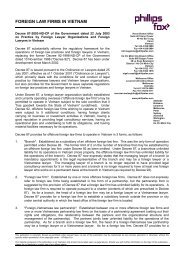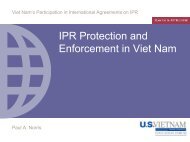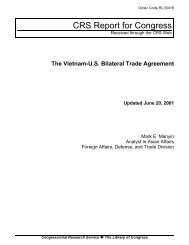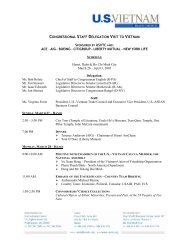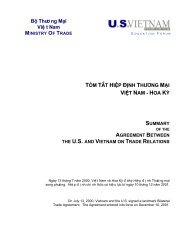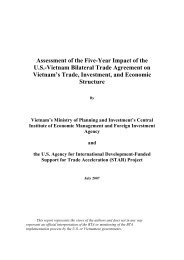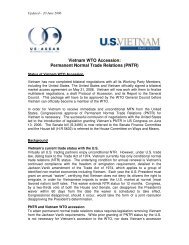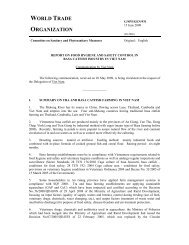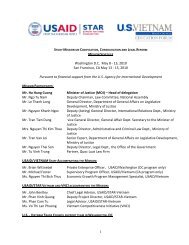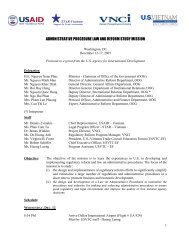Climate risks and adaptation in Asian coastal megacities: A synthesis
Climate risks and adaptation in Asian coastal megacities: A synthesis
Climate risks and adaptation in Asian coastal megacities: A synthesis
- No tags were found...
You also want an ePaper? Increase the reach of your titles
YUMPU automatically turns print PDFs into web optimized ePapers that Google loves.
Damage costs <strong>in</strong> 2050 are largelyattributable to l<strong>and</strong> subsidenceL<strong>and</strong> subsidence as a result of groundwater utilizationis a major problem <strong>in</strong> Bangkok. While there isreason to worry about climate change, the impactsof l<strong>and</strong> subsidence are even bigger. For example,if we look at the impacts of a 1-<strong>in</strong>-30-year flood <strong>in</strong>Table 4.2, with current (2008) climate conditions, thecosts are about THB 35 billion ($1 billion). However,this <strong>in</strong>creases to THB 99 billion ($3 billion) <strong>in</strong> 2050,just from expected l<strong>and</strong> subsidence (2050-LS). Thus,there is a nearly two-fold (181 percent) <strong>in</strong>crease <strong>in</strong>flood<strong>in</strong>g costs between 2050 <strong>and</strong> 2008 as a result ofl<strong>and</strong> subsidence.If we add climate change to this projectedchange <strong>in</strong> l<strong>and</strong> subsidence <strong>and</strong> estimate damagecosts <strong>in</strong> the context of a 2050-LS-SR-SS-A1FI scenario,the costs of a 1-<strong>in</strong>-30-year flood are THB 148billion ($4.5 billion). <strong>Climate</strong> change results <strong>in</strong> afurther 49 percent <strong>in</strong>crease <strong>in</strong> flood damage costs<strong>in</strong> 2050 (relative to 2050-LS). However, the bulk ofthe <strong>in</strong>crease (67 percent) <strong>in</strong> flood<strong>in</strong>g costs <strong>in</strong> 2050is attributable to l<strong>and</strong> subsidence. Thus, <strong>in</strong> order toreduce the costs of flood<strong>in</strong>g <strong>in</strong> 2050, a top priority shouldbe policies to reduce l<strong>and</strong> subsidence.Damage costs vary by sectors, with morethan 75 percent of the costs attributable tobuild<strong>in</strong>gsDamage to build<strong>in</strong>gs dom<strong>in</strong>ates flood-related costs<strong>in</strong> Bangkok. In the context of a 1-<strong>in</strong>-30-year flood,<strong>in</strong> each of the five climate <strong>and</strong> l<strong>and</strong> scenarios consideredfor Bangkok, 76–77 percent of total damagecosts are attributable to damage to build<strong>in</strong>gs. AsTable 4.2 shows, <strong>in</strong> 2008, a 1-<strong>in</strong>-30-year flood couldcause build<strong>in</strong>g damages to the extent of THB 27 billion($800 million) <strong>in</strong> Bangkok. A similar 1-<strong>in</strong>-30-yearflood could cost up to THB 75 billion ($2.3 billion) <strong>in</strong>2050 after tak<strong>in</strong>g <strong>in</strong>to account l<strong>and</strong> subsidence <strong>and</strong>economic development. If we add climate changeimpacts, the damage costs further <strong>in</strong>crease by 51percent to THB 110 billion ($3.4 billion). 47 There is asteep <strong>in</strong>crease <strong>in</strong> build<strong>in</strong>g costs between 2008 <strong>and</strong>2050 (177 percent) simply because of l<strong>and</strong> subsidence(Table 4.2). The <strong>in</strong>crease <strong>in</strong> damages from climatechange is also significant, but less steep.Damage costs to transport are likely to belimitedThe Bangkok study exam<strong>in</strong>ed different types of <strong>in</strong>frastructure<strong>and</strong> sought to underst<strong>and</strong> the impact offloods on public <strong>in</strong>vestments. In general, new public<strong>in</strong>frastructure <strong>in</strong> Bangkok has taken the possibilityof flood<strong>in</strong>g <strong>in</strong>to account. For example, because ofthe height at which highways <strong>and</strong> the metro rail arebuilt, transportation will generally be unaffected byflood<strong>in</strong>g. This does not mean that small streets <strong>in</strong>Bangkok will not be flooded, but the economic coststo transport <strong>in</strong>frastructure is expected to be limited.The Bangkok study was unable to estimate the trafficdelay costs associated with flood<strong>in</strong>g, <strong>and</strong> thereforethis potentially important cost is not <strong>in</strong>cluded.There are unlikely to be direct water <strong>and</strong> sanitation<strong>in</strong>frastructure-related costs because of theirlocation at higher than flood levels. However, thereare likely to be revenue losses to water <strong>and</strong> sanitationagencies if flood waters rise above 2 meters.Under these conditions water supply may becomedysfunctional <strong>and</strong> the agencies will likely <strong>in</strong>cur revenuelosses. 48 The revenue loss to water supply <strong>and</strong>sanitation utilities is expected to more than doubleto THB 13 million ($390, 235) <strong>in</strong> 2050, given climatechange (A1FI), sea level rise, storm surge, <strong>and</strong> l<strong>and</strong>subsidence. However, the bulk of this <strong>in</strong>crease <strong>in</strong>costs is attributable to l<strong>and</strong> subsidence.If flood<strong>in</strong>g is higher than 1 meter, the MetropolitanElectricity Authority will lose revenues tothe extent of THB 1.1 billion ($33 million) <strong>in</strong> 2050(A1FI-SL-SR-SS-T30). The damages with climatechange are twice the damages that are likely to occur<strong>in</strong> a no-climate-change scenario (2050-LS-T30).However, <strong>in</strong>frastructural damages are limited becauseenergy to Bangkok is supplied by two powerplants that are either be<strong>in</strong>g retired or will be retiredby 2050. Future <strong>in</strong>frastructure is expected to be47These values are all <strong>in</strong> 2008 THB <strong>and</strong> reflect simply thephysical changes that would be wrought as a result of climatechange, economic development, <strong>and</strong> l<strong>and</strong> subsidence.48The average losses are calculated by multiply<strong>in</strong>g watercharges by the average water used per day <strong>and</strong> scal<strong>in</strong>g thisup for the duration of floods <strong>and</strong> number people affected ifflood waters were higher than 2 meters. Similarly, sanitationcosts = No. of affected people x waste generation (solid <strong>and</strong>liquid) per capita per day x treatment cost x flood duration54 | <strong>Climate</strong> Risks <strong>and</strong> Adaptation <strong>in</strong> <strong>Asian</strong> Coastal Megacities: A Synthesis Report



